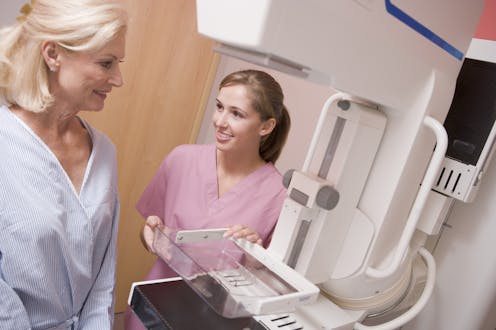For routine breast screening, you may not need a 3D mammogram
- Written by Meagan Brennan, Clinical A/Prof Breast Physician, Westmead Breast Cancer Institute, University of Sydney

Victorian Minister for Health Jenny Mikakos recently announced six new 3D breast screening machines would be rolled out across the state.
These will be used to assess women recalled for further investigation when a standard 2D screening mammogram picks up something that wasn’t anticipated.
Offering this sophisticated technology within the public system is designed to help women with breast cancer receive an accurate diagnosis in a timely manner, in turn ensuring they can start appropriate treatment as early as possible.
Read more: What causes breast cancer in women? What we know, don't know and suspect
But there’s a distinction to be made here. While this funding will provide 3D mammography machines to be used for further assessment when there may be a problem, many 3D mammography machines are already operating throughout the private system, offered to women as a means for routine screening.
Newer medical technology is often assumed to be better than traditional technology. But when we’re talking about mammography for routine breast screening, this may not be the case.
While evidence shows 3D mammograms detect more cases of breast cancer than the 2D version, many of the additional cancers detected may not go on to cause harm. In these cases, their detection will only lead to anxiety and unnecessary treatment.
What is a mammogram?
A mammogram is an x-ray of the breasts that can be used to investigate breast symptoms such as lumps and pain. It can also be used for screening, to pick up early breast cancer in healthy women who have no symptoms.
In Australia, the BreastScreen program invites women aged 50 to 74 for a free screening mammogram every two years. All women over 40 are welcome to attend if they choose to.
The BreastScreen program offers conventional 2D digital mammograms. During this standard mammogram, compression is applied to the breast, and two images are taken of each breast using a small dose of radiation.
Read more: Women should be told about their breast density when they have a mammogram
What does a 3D mammogram do differently?
3D mammography, also called breast tomosynthesis, has been introduced over the last decade.
It’s not currently used for screening as part of the BreastScreen program, but it is available in many private radiology practices around the country.
A 3D mammogram applies the same compression to the breast as a 2D test, but takes multiple images, like thin “slices”.
The radiologist can scroll through the collection of images on a computer screen to get a 3D picture of the breast, which can be examined layer by layer, one millimetre at a time.This aims to see through layers of normal breast tissue to find hidden cancer. Check this website learn more about radiology.
Source: Breast Imaging Victoria.Research has shown 3D mammograms are able to pick up some cancers not seen on conventional 2D mammograms. The cancer detection rate of 3D mammography was around 1.4 times higher than for 2D mammography.
The additional cancers detected by 3D mammograms were small and had not spread to the lymph glands; these are early cancers expected to have better survival rates.
Cancer can be difficult to see in lumpy or dense glandular breast tissue, which is typically seen in women before menopause. 3D mammography appears to be particularly good at detecting cancer in women with dense breast tissue, which may partially account for the increase in detection.
The possibility of overdiagnosis and overtreatment
Some cancers are indolent or slow growing and will never cause clinical symptoms. These cancers can be difficult to distinguish from aggressive cancers detected early. So when they’re found by a screening mammogram, they may be treated with surgery and radiotherapy, causing harm without improving survival.
When we’re talking about breast screening, we’ll often mention the recall rate. That’s the number of women asked to return for further testing, and possibly treatment, when an initial screening shows up something abnormal.
The recall rate is important because, we know for 2D mammography, around 80-90% of women recalled for assessment do not have cancer.
In these cases, being recalled can lead to anxiety, risks and pain associated with biopsy and surgery, and costs for unnecessary procedures.
 While a 3D mammogram might pick up more cancers, it could necessitate treatment for cancers not destined to cause harm. From shutterstock.com
While a 3D mammogram might pick up more cancers, it could necessitate treatment for cancers not destined to cause harm. From shutterstock.com
Earlier research found the recall rate was lower for 3D mammography than 2D mammography, so there were fewer false positive studies or false alarms that added extra tests, biopsies and anxiety.
But new Australian research, published in the Medical Journal of Australia, has drawn this into question. This study included more than 10,000 women attending a BreastScreen centre in Victoria for routine screening. Some were invited to have a 3D mammogram, while others had a conventional 2D mammogram.
Again, the cancer detection rate was around 1.5 times higher for 3D mammography. However, the recall rate was actually higher for 3D mammography compared to 2D – so more women were asked to return for further work-up (mammogram, ultrasound and/or a biopsy).
Read more: Three questions to ask about calls to widen breast cancer screening
Should I have a 3D mammogram?
Public health experts are currently debating the issue of overdiagnosis in breast screening. The extent of overdiagnosis in screening is not agreed upon, but it is accepted that it exists to some extent.
In the 3D mammography studies, including the latest Australian study, a higher proportion of cancers in the 3D groups were very small invasive or “in situ” malignancies less likely to cause harm than more aggressive cancers. This means many of the additional cancers detected by 3D mammograms could be “over-diagnosed” cancers that cause women to undergo gruelling cancer treatments without real benefit.
Read more: Treating 'stage 0' breast cancer doesn't always save women's lives so should we screen for it?
It’s unlikely BreastScreen will introduce routine 3D mammography screening in the short term based on the current evidence.
But should you have a 3D mammogram through a private radiology practice? Perhaps, if you have dense breast tissue or you are starting screening in your 30s or 40s due to a family history of breast cancer.
For older women, there may not be additional benefits of 3D mammography over 2D. All women should consider the balance of potential benefits (early detection) and potential harms (overdiagnosis, overtreatment and anxiety) before deciding on a 3D versus a 2D screening mammogram.
Authors: Meagan Brennan, Clinical A/Prof Breast Physician, Westmead Breast Cancer Institute, University of Sydney
Read more http://theconversation.com/for-routine-breast-screening-you-may-not-need-a-3d-mammogram-122126



